Characterization, Cytotoxicity and Anti-Inflammatory Effect Evaluation of Nanocapsules Containing Nicotine
Abstract
:1. Introduction
2. Materials and Methods
2.1. Preparation of Eudragit Nanocapsules Containing Nicotine
2.2. Nanocapsule Characterization
2.2.1. Structural Analysis
2.2.2. Determination of pH
2.2.3. Nanocapsule Diameter and Zeta Potential
2.2.4. Determination of Nanocapsule Nicotine Content and Encapsulation Efficiency
2.2.5. Sustained Release Profile
2.2.6. Nanocapsule Stability
2.3. In Vitro Treatment of Cells with Eudragit Nanocapsules Containing Nicotine
2.3.1. Cytotoxic Effect and Cellular Viability
Cell Culture
Nanocapsule Sterilization
Experimental Groups
- Cells cultivated on a tissue culture plate without nanocapsule treatment (control);
- Cells treated with 166 μg/mL of empty Eudragit nanocapsules (equivalent to group 4 concentration of Eudragit) (EN100);
- Cells treated with 833 μg/mL empty Eudragit nanocapsules (equivalent to group 5 concentration of Eudragit) (EN500);
- Cells treated with Eudragit nanocapsules containing 100 μM of nicotine (NNC100);
- Cells treated with Eudragit nanocapsules containing 500 μM of nicotine (NNC500);
- Cells treated with 100 μM of bulk nicotine dissolved in deionized water (NIC100);
- Cells treated with 500 μM of bulk nicotine dissolved in deionized water (NIC500);
MTT Assay
2LIVE/DEAD Assay
2.3.2. Cytokine Dosage
2.3.3. Statistical Analysis
3. Results
3.1. Nanocapsule Characterization
3.1.1. Macro and Microscopic Aspect
3.1.2. Determination of pH
3.1.3. Encapsulation Efficiency
3.1.4. Nanocapsule Stability
3.1.5. Sustained Release Profile
3.2. Cell Viability
3.3. Cytokine Expression Evaluation
4. Discussion
5. Conclusions
Author Contributions
Funding
Institutional Review Board Statement
Informed Consent Statement
Data Availability Statement
Conflicts of Interest
References
- De Morais, M.G.; Martins, V.G.; Steffens, D.; Pranke, P.; da Costa, J.A.V. Biological Applications of Nanobiotechnology. J. Nanosci. Nanotechnol. 2014, 14, 1007–1017. [Google Scholar] [CrossRef]
- Fakruddin, M.; Hossain, Z.; Afroz, H. Prospects and applications of nanobiotechnology: A medical perspective. J. Nanobiotechnol. 2012, 10, 31. [Google Scholar] [CrossRef] [PubMed] [Green Version]
- Schaffazick, S.R.; Guterres, S.; Freitas, L.D.L.; Pohlmann, A.R. Caracterização e estabilidade físico-química de sistemas poliméricos nanoparticulados para administração de fármacos. Quim. Nova 2003, 26, 726–737. [Google Scholar] [CrossRef]
- Thakral, S.; Thakral, N.K.; Majumdar, D.K. Eudragit®: A technology evaluation. Expert Opin. Drug Deliv. 2013, 10, 131–149. [Google Scholar] [CrossRef] [PubMed]
- Ramzy, L.; Metwally, A.A.; Nasr, M.; Awad, G.A.S. Novel thymoquinone lipidic core nanocapsules with anisamide-polymethacrylate shell for colon cancer cells overexpressing sigma receptors. Sci. Rep. 2020, 10, 10987. [Google Scholar] [CrossRef] [PubMed]
- Qelliny, M.R.; Aly, U.F.; Elgarhy, O.H.; Khaled, K.A. Budesonide-Loaded Eudragit S 100 Nanocapsules for the Treatment of Acetic Acid-Induced Colitis in Animal Model. AAPS PharmSciTech 2019, 20, 237. [Google Scholar] [CrossRef] [PubMed]
- Jaguezeski, A.M.; Gündel, S.S.; Favarin, F.R.; Gündel, A.; Souza, C.F.; Baldissera, M.D.; Cazarotto, C.C.; Volpato, A.; Fortuoso, B.F.; Ourique, A.F.; et al. Low-dose curcumin-loaded Eudragit L-100-nanocapsules in the diet of dairy sheep increases antioxidant levels and reduces lipid peroxidation in milk. J. Food Biochem. 2019, 43, e12942. [Google Scholar] [CrossRef]
- Srikanth, M.; Kessler, J.A. Nanotechnology—Novel therapeutics for CNS disorders. Nat. Rev. Neurol. 2012, 8, 307–318. [Google Scholar] [CrossRef] [Green Version]
- Moura, R.; Pacheco, A.C.S.; Pêgo, A.P.; Rieux, A.D.; Sarmento, B. Lipid nanocapsules to enhance drug bioavailability to the central nervous system. J. Control. Release 2020, 322, 390–400. [Google Scholar] [CrossRef] [PubMed]
- Shih, R.-H.; Wang, C.-Y.; Yang, C.-M. NF-kappaB Signaling Pathways in Neurological Inflammation: A Mini Review. Front. Mol. Neurosci. 2015, 8, 77. [Google Scholar] [CrossRef] [Green Version]
- Benowitz, N.L.; Hukkanen, J.; Jacob, P. Nicotine Chemistry, Metabolism, Kinetics and Biomarkers. Handb. Exp. Pharmacol. 2009, 192, 29–60. [Google Scholar] [CrossRef] [Green Version]
- Han, Y.; Lau, Y.-L. Nicotine, an anti-inflammation molecule. Inflamm. Cell Signal. 2014, 1, 10. [Google Scholar] [CrossRef]
- Wang, H.; Yu, M.; Ochani, M.; Amella, C.A.; Tanovic, M.; Susarla, S.; Li, J.H.; Wang, H.; Yang, H.; Ulloa, L.; et al. Nicotinic acetylcholine receptor α7 subunit is an essential regulator of inflammation. Nature 2003, 421, 384–388. [Google Scholar] [CrossRef]
- Piao, W.-H.; Campagnolo, D.; Dayao, C.; Lukas, R.J.; Wu, J.; Shi, F.-D. Nicotine and inflammatory neurological disorders. Acta Pharmacol. Sin. 2009, 30, 715–722. [Google Scholar] [CrossRef] [PubMed] [Green Version]
- Lee, M.-Y.; Chen, L.; Toborek, M. Nicotine attenuates iNOS expression and contributes to neuroprotection in a compressive model of spinal cord injury. J. Neurosci. Res. 2009, 87, 937–947. [Google Scholar] [CrossRef] [PubMed]
- Kaur, J.; Rauti, R.; Nistri, A. Nicotine-mediated neuroprotection of rat spinal networks against excitotoxicity. Eur. J. Neurosci. 2018, 47, 1353–1374. [Google Scholar] [CrossRef] [PubMed]
- Dalcin, A.J.F.; Vizzotto, B.S.; Bochi, G.V.; Guarda, N.S.; Nascimento, K.; Sagrillo, M.R.; Moresco, R.N.; Schuch, A.P.; Ourique, A.F.; Gomes, P. Nanoencapsulation of the flavonoid dihydromyricetin protects against the genotoxicity and cytotoxicity induced by cationic nanocapsules. Colloids Surf. B Biointerfaces 2019, 173, 798–805. [Google Scholar] [CrossRef]
- Katzer, T.; Chaves, P.; Bernardi, A.; Pohlmann, A.; Guterres, S.; Beck, R. Prednisolone-loaded nanocapsules as ocular drug delivery system: Development, in vitrodrug release and eye toxicity. J. Microencapsul. 2014, 31, 519–528. [Google Scholar] [CrossRef]
- Chaves, P.D.S.; Ourique, A.; Frank, L.A.; Pohlmann, A.; Guterres, S.; Beck, R.C.R. Carvedilol-loaded nanocapsules: Mucoadhesive properties and permeability across the sublingual mucosa. Eur. J. Pharm. Biopharm. 2017, 114, 88–95. [Google Scholar] [CrossRef] [PubMed]
- Blouza, I.L.; Charcosset, C.; Sfar, S.; Fessi, H. Preparation and characterization of spironolactone-loaded nanocapsules for paediatric use. Int. J. Pharm. 2006, 325, 124–131. [Google Scholar] [CrossRef]
- Fischer, H.C.; Chan, W.C. Nanotoxicity: The growing need for in vivo study. Curr. Opin. Biotechnol. 2007, 18, 565–571. [Google Scholar] [CrossRef] [PubMed]
- Elsaesser, A.; Howard, C.V. Toxicology of nanoparticles. Adv. Drug Deliv. Rev. 2012, 64, 129–137. [Google Scholar] [CrossRef]
- Chvatal, S.A.; Kim, Y.-T.; Bratt-Leal, A.M.; Lee, H.; Bellamkonda, R.V. Spatial distribution and acute anti-inflammatory effects of Methylprednisolone after sustained local delivery to the contused spinal cord. Biomaterials 2008, 29, 1967–1975. [Google Scholar] [CrossRef] [Green Version]
- Tiwari, M.N.; Agarwal, S.; Bhatnagar, P.; Singhal, N.K.; Tiwari, S.K.; Kumar, P.; Chauhan, L.K.S.; Patel, D.K.; Chaturvedi, R.K.; Singh, M.P.; et al. Nicotine-encapsulated poly(lactic-co-glycolic) acid nanoparticles improve neuroprotective efficacy against MPTP-induced parkinsonism. Free. Radic. Biol. Med. 2013, 65, 704–718. [Google Scholar] [CrossRef] [PubMed]
- Larner, S.F.; Wang, J.; Goodman, J.; Altman, M.B.O.; Xin, M.; Wang, K. In Vitro Neurotoxicity Resulting from Exposure of Cultured Neural Cells to Several Types of Nanoparticles. J. Cell Death 2017, 10, 1–7. [Google Scholar] [CrossRef] [PubMed] [Green Version]
- Severino, P.; Santana, M.H.A.; Malmonge, S.M.; Souto, E.B. Polímeros usados como sistemas de transporte de princípios ativos. Polímeros 2011, 21, 361–368. [Google Scholar] [CrossRef] [Green Version]
- Eidi, H.; Joubert, O.; Attik, G.; Duval, R.; Bottin, M.; Hamouia, A.; Maincent, P.; Rihn, B. Cytotoxicity assessment of heparin nanoparticles in NR8383 macrophages. Int. J. Pharm. 2010, 396, 156–165. [Google Scholar] [CrossRef]
- Bethea, J.R. Spinal cord injury-induced inflammation: A dual-edged sword. Prog. Brain Res. 2000, 128, 33–42. [Google Scholar] [CrossRef]
- Obst, K.; Yealland, G.; Balzus, B.; Miceli, E.; Dimde, M.; Weise, C.; Eravci, M.; Bodmeier, R.; Haag, R.; Calderón, M.; et al. Protein Corona Formation on Colloidal Polymeric Nanoparticles and Polymeric Nanogels: Impact on Cellular Uptake, Toxicity, Immunogenicity, and Drug Release Properties. Biomacromolecules 2017, 18, 1762–1771. [Google Scholar] [CrossRef]
- Deng, Z.J.; Liang, M.; Monteiro, M.; Toth, I.; Minchin, R.F. Nanoparticle-induced unfolding of fibrinogen promotes Mac-1 receptor activation and inflammation. Nat. Nanotechnol. 2011, 6, 39–44. [Google Scholar] [CrossRef]
- Fujii, T.; Hayashi, S.; Hogg, J.C.; Vincent, R.; Van Eeden, S.F. Particulate Matter Induces Cytokine Expression in Human Bronchial Epithelial Cells. Am. J. Respir. Cell Mol. Biol. 2001, 25, 265–271. [Google Scholar] [CrossRef]
- Fattal, E.; Mura, S.; Nicolas, J.; Hillaireau, H.; Gueutin, C.; Le Droumaguet, B.; Zanna, S.; Tsapis, N. Influence of surface charge on the potential toxicity of PLGA nanoparticles towards Calu-3 cells. Int. J. Nanomed. 2011, 6, 2591–2605. [Google Scholar] [CrossRef] [PubMed] [Green Version]
- Cho, E.C.; Zhang, Q.; Xia, Y. The effect of sedimentation and diffusion on cellular uptake of gold nanoparticles. Nat. Nanotechnol. 2011, 6, 385–391. [Google Scholar] [CrossRef] [PubMed]
- Adjei, I.M.; Sharma, B.; Labhasetwar, V. Nanoparticles: Cellular Uptake and Cytotoxicity. Adv. Exp. Med. Biol. 2014, 811, 74–91. [Google Scholar] [CrossRef]
- Shang, L.; Nienhaus, K.; Nienhaus, G.U. Engineered nanoparticles interacting with cells: Size matters. J. Nanobiotechnol. 2014, 12, 5. [Google Scholar] [CrossRef] [PubMed] [Green Version]
- Pereira, M.P.; de Gomes, M.G.; Izoton, J.C.; Nakama, K.A.; Dos Santos, R.B.; Savall, A.S.P.; Ramalho, J.B.; Roman, S.S.; Luchese, C.; Cibin, F.W.S.; et al. Cationic and anionic unloaded polymeric nanocapsules: Toxicological evaluation in rats shows low toxicity. Biomed. Pharmacother. 2019, 116, 109014. [Google Scholar] [CrossRef] [PubMed]
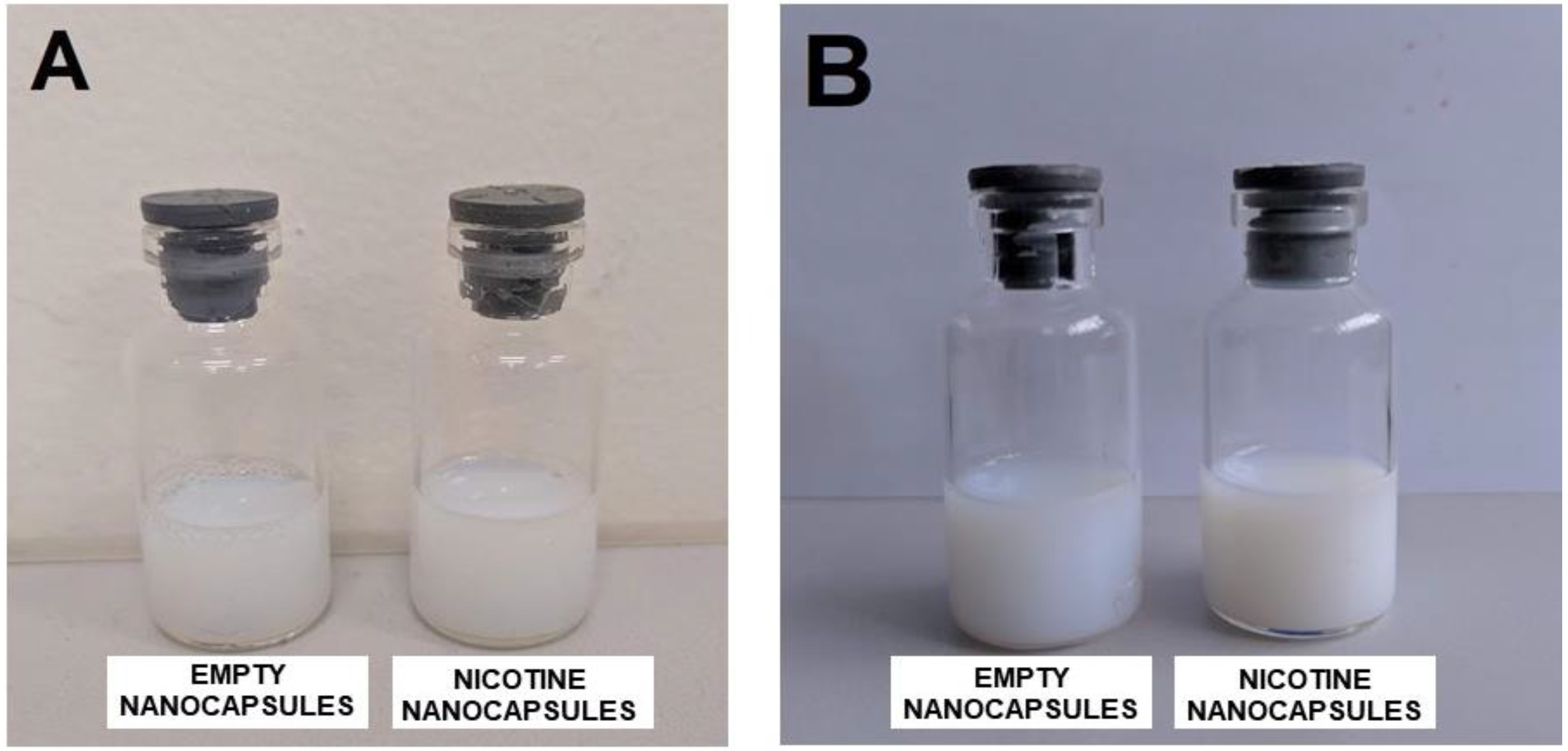



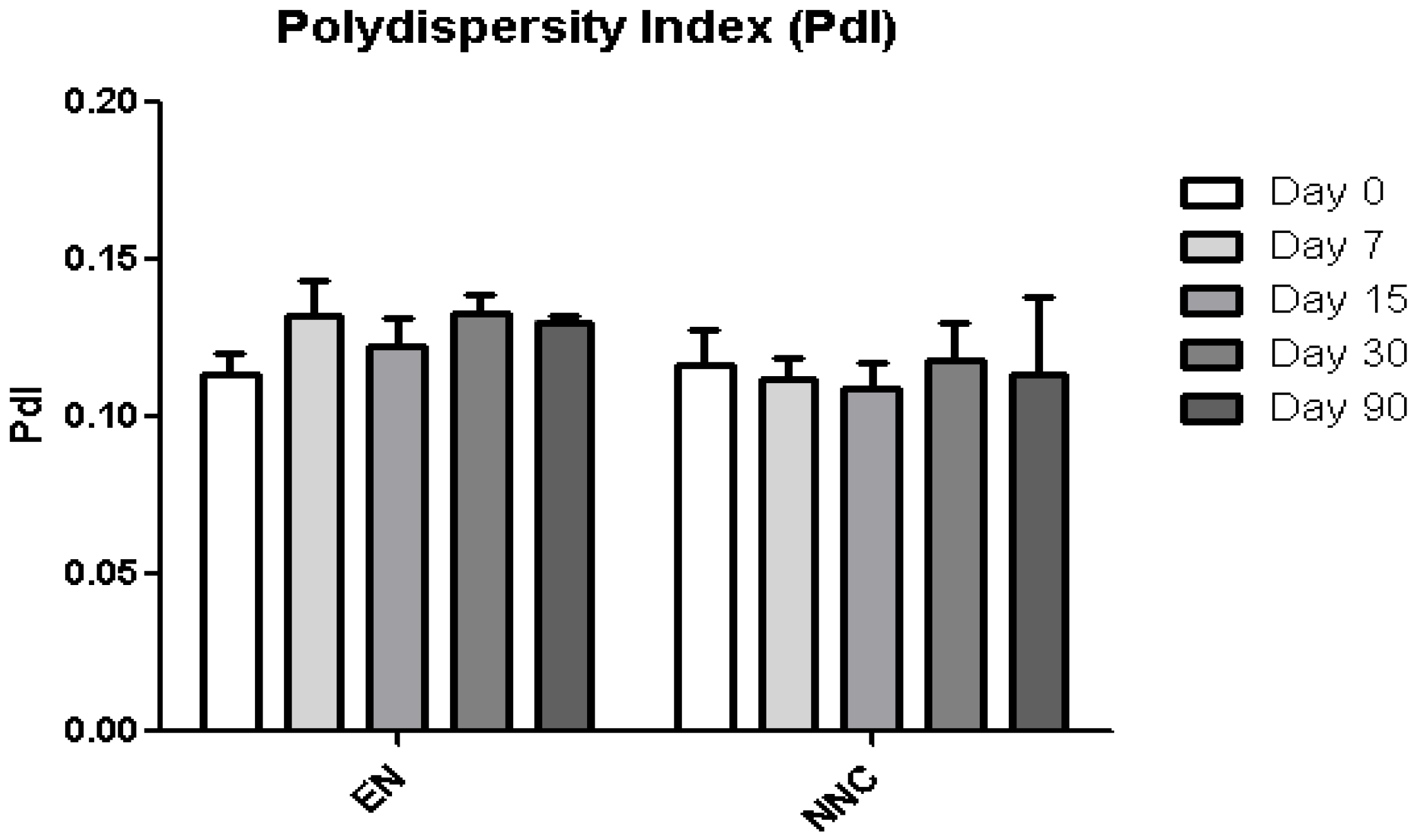
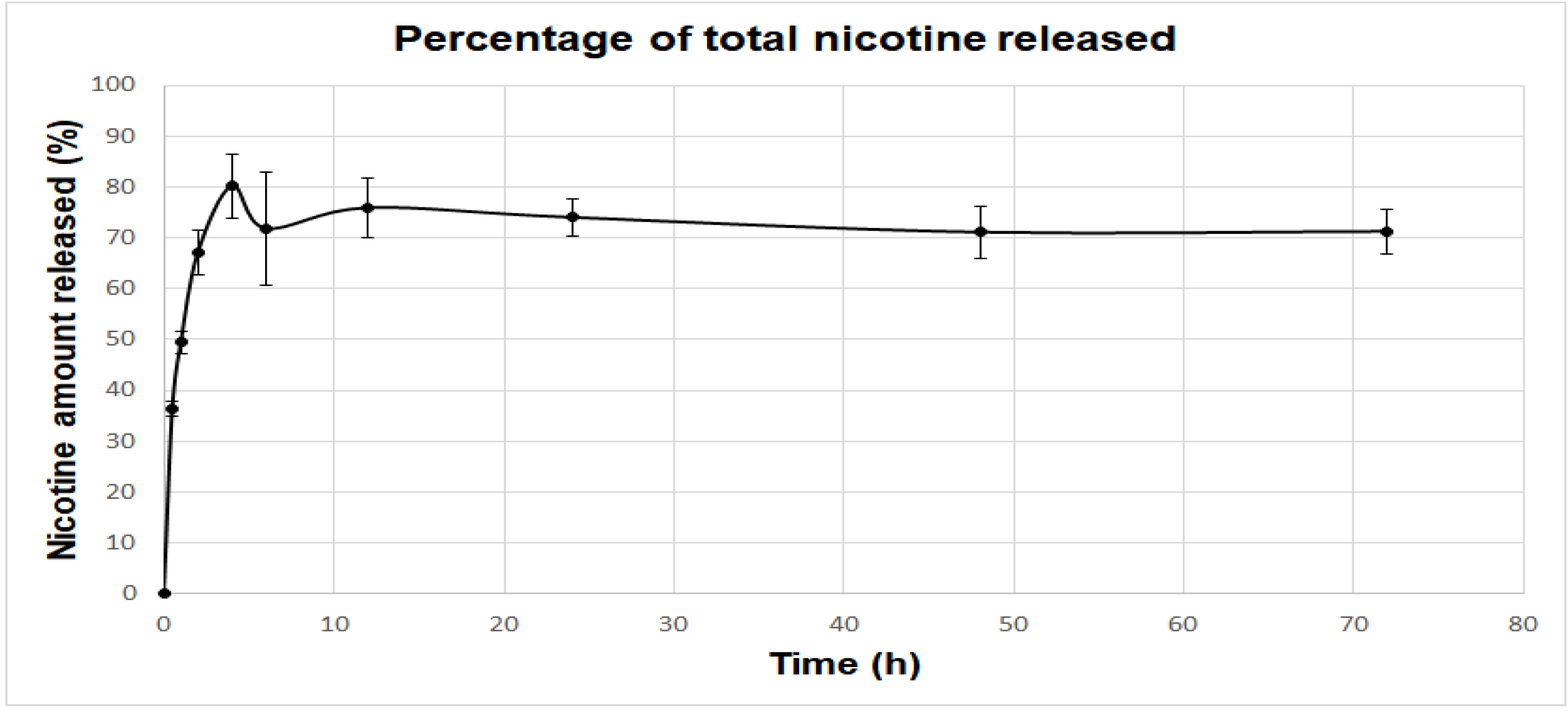

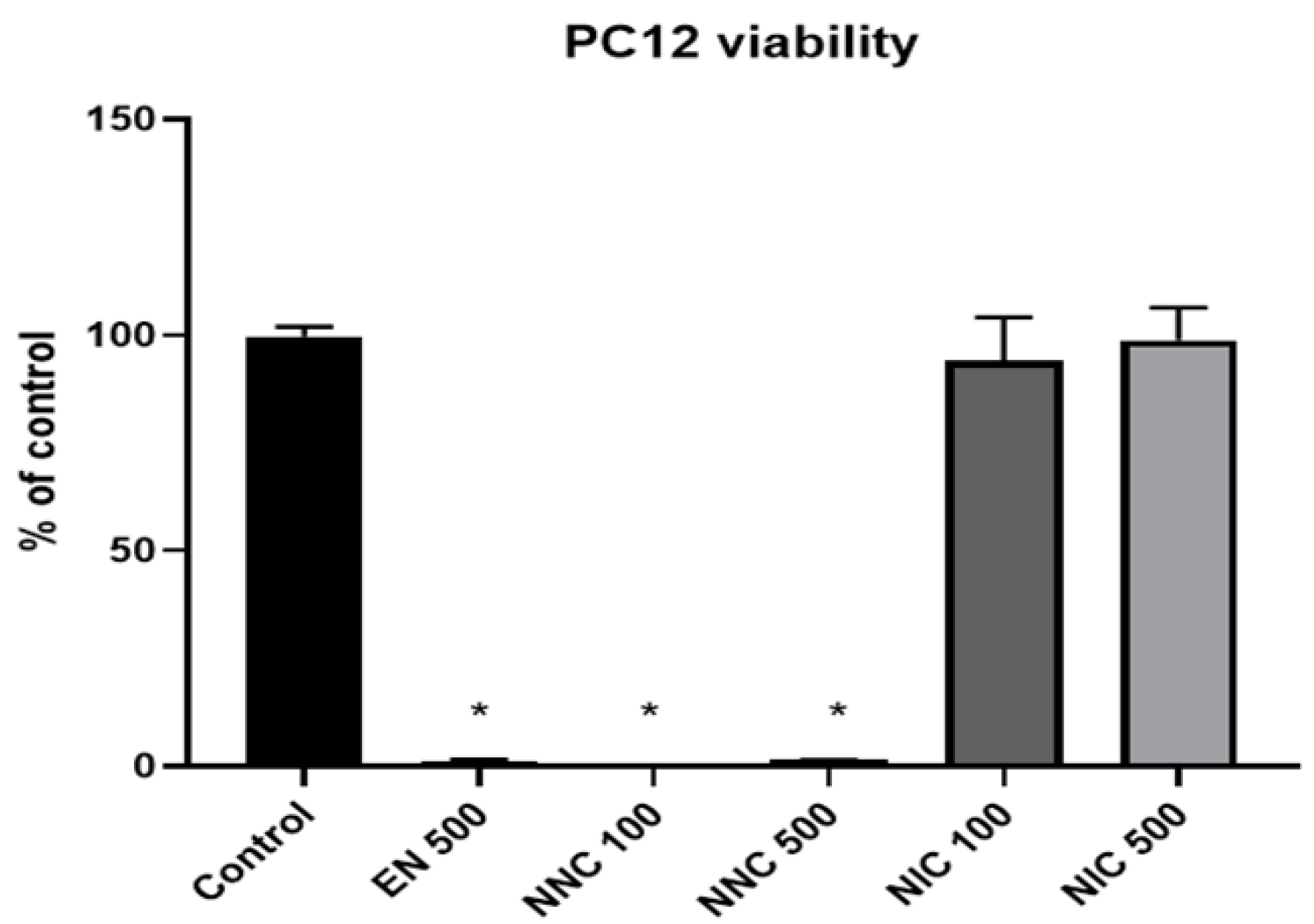
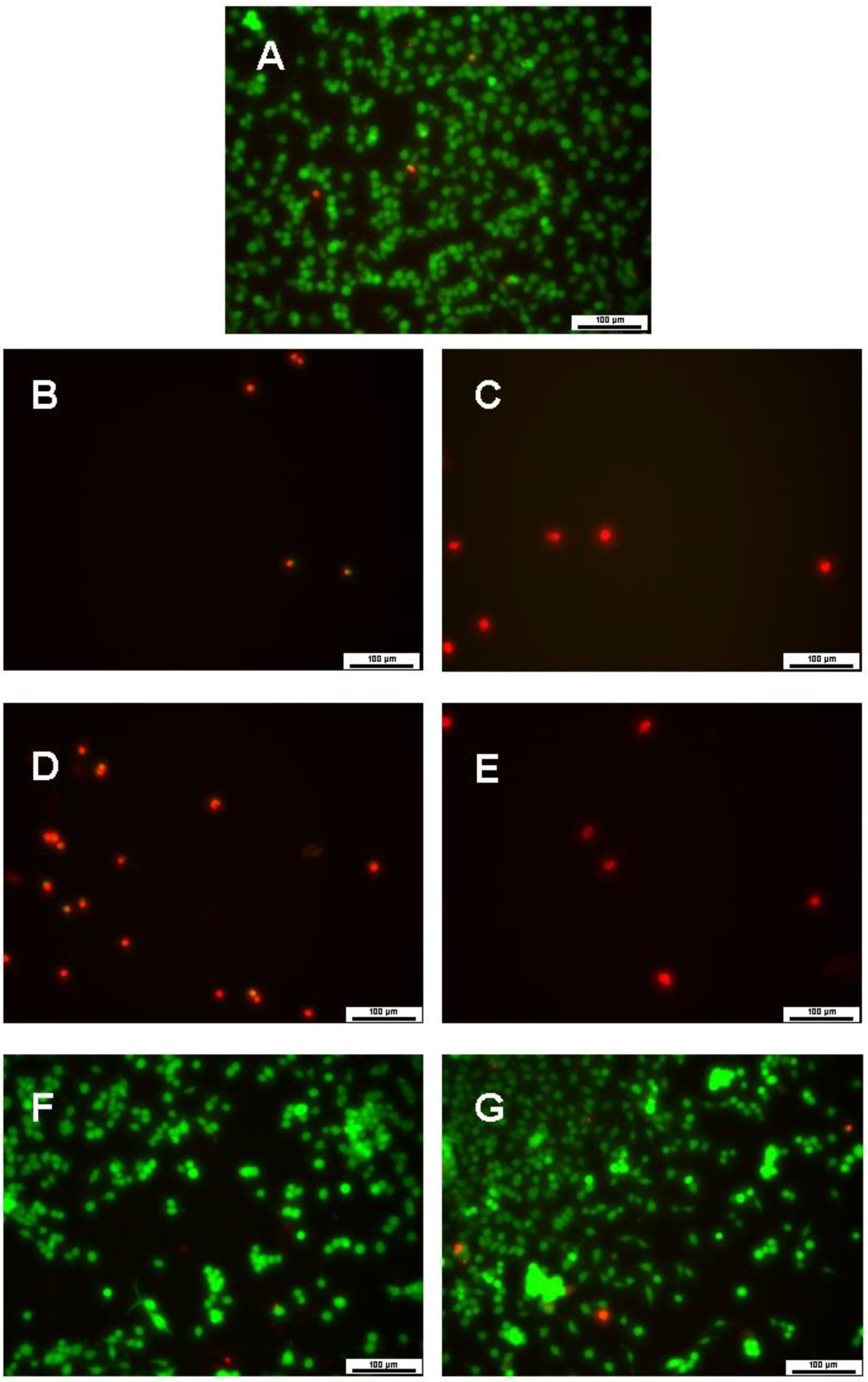

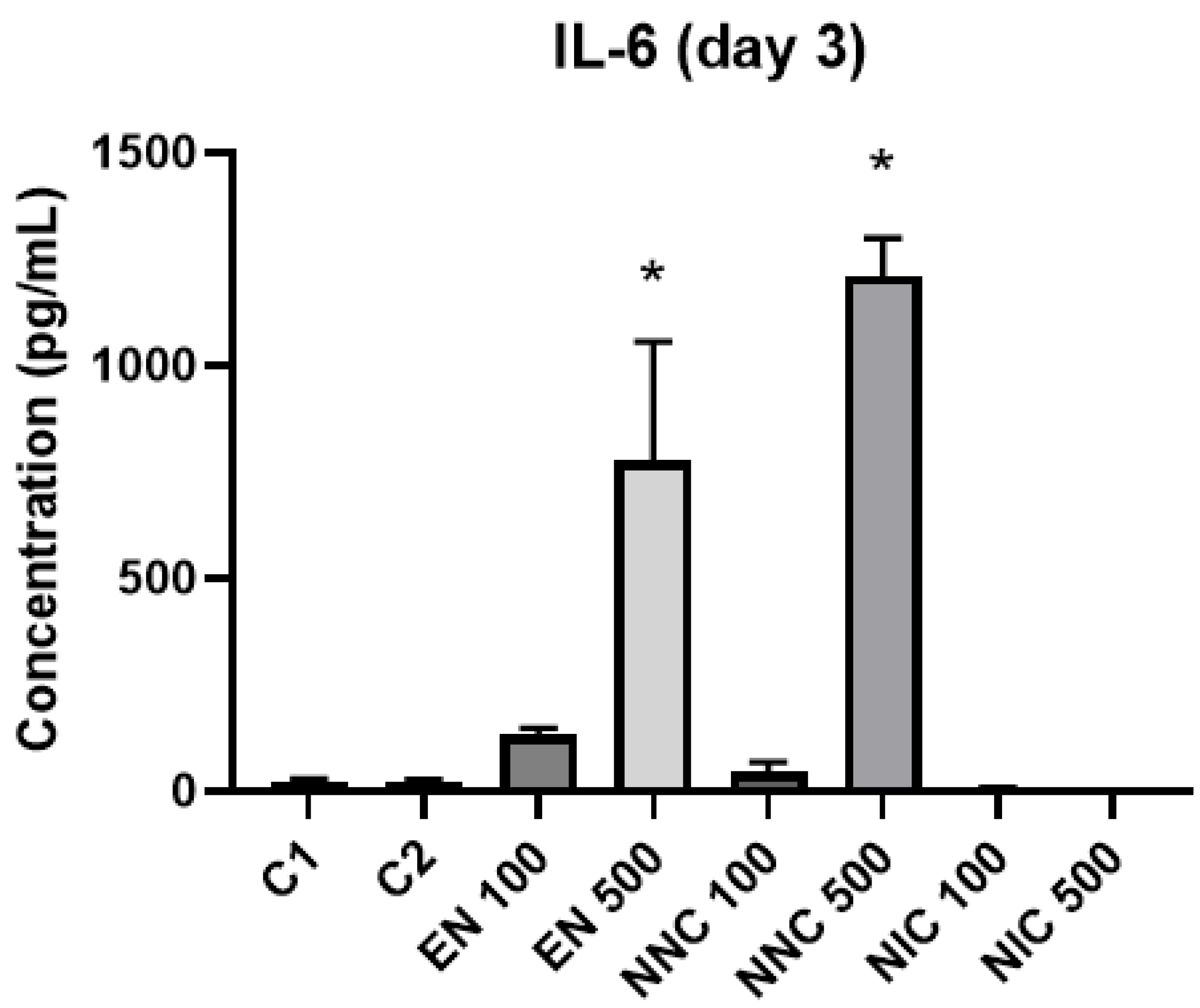

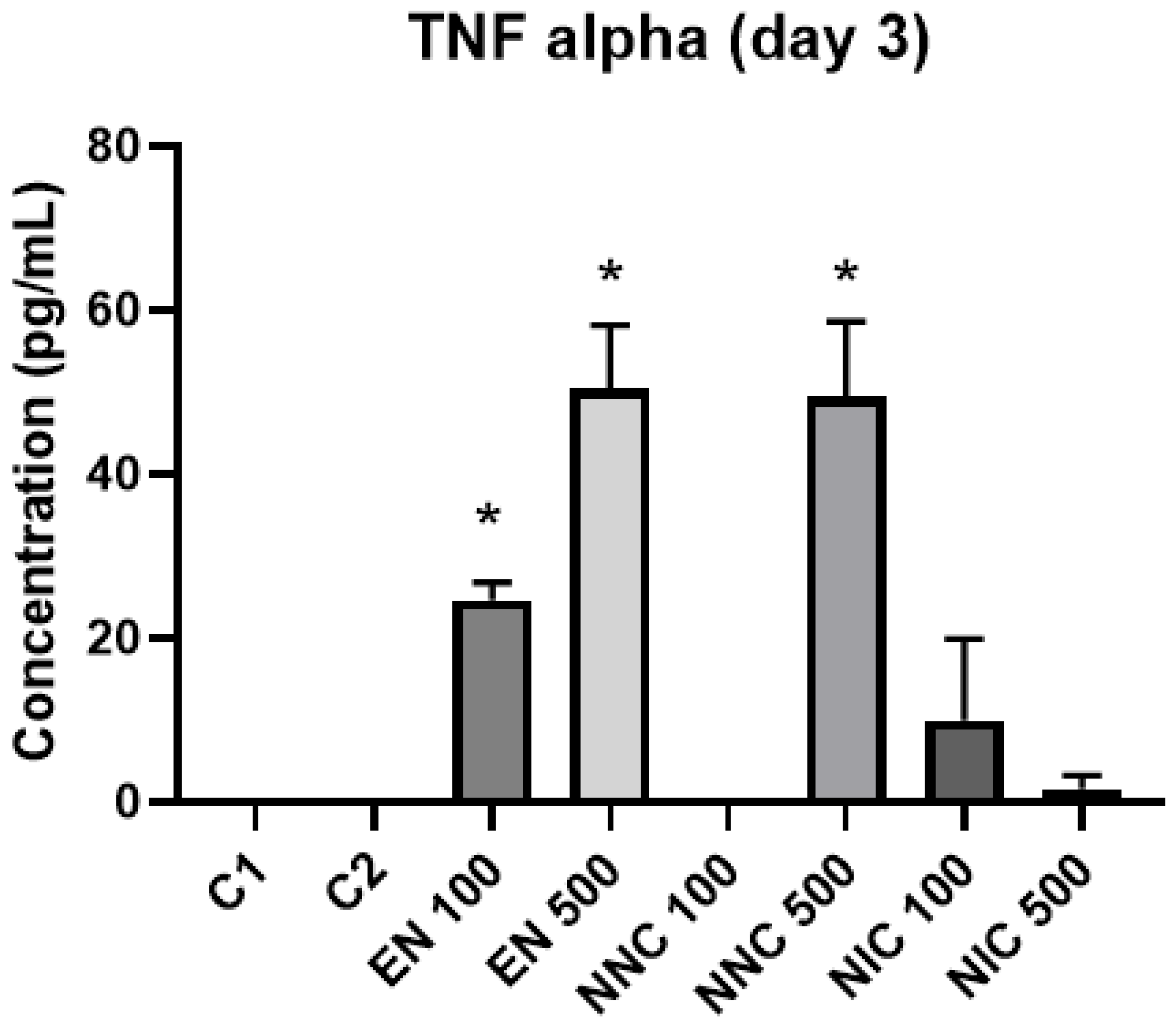
| Day 0 | ||||
| ZP (mV) | Diameter (nm) | PdI | pH | |
| EN | 45.02 ± 2.95 | 115.05 ± 7.24 | 0.113 ± 0.017 | 5.67 ± 0.288 |
| NNC | 46.77 ± 2.17 | 139.05 ± 18.85 | 0.116 ± 0.018 | 4.33 ± 0.288 |
| Day 7 | ||||
| ZP (mV) | Diameter (nm) | PdI | pH | |
| EN | 42.91 ± 9.08 | 118.17 ± 8.04 | 0.131 ± 0.021 | 5.67 ± 0.288 |
| NNC | 45.83 ± 4.73 | 123.45 ± 20.4 | 0.111 ± 0.015 | 4.33 ± 0.288 |
| Day 15 | ||||
| ZP (mV) | Diameter (nm) | PdI | pH | |
| EN | 44.16 ± 6.10 | 117.29 ± 9.25 | 0.122 ± 0.017 | 5.75 ± 0.25 |
| NNC | 47.56 ± 3.66 | 123.78 ± 18.5 | 0.101 ± 0.016 | 4.33 ± 0.288 |
| Day 30 | ||||
| ZP (mV) | Diameter (nm) | PdI | pH | |
| EN | 41.82 ± 7.19 | 118.35 ± 7.80 | 0.132 ± 0.014 | 5.83 ± 0.288 |
| NNC | 43.1 ± 5.93 | 125.9 ± 16.7 | 0.117 ± 0.02 | 4.16 ± 0.288 |
| Day 90 | ||||
| ZP (mV) | Diameter (nm) | PdI | pH | |
| EN | 50.83 ± 5.59 | 116.78 ± 9.81 | 0.114 ± 0.029 | 6.0 ± 0.0 |
| NNC | 51.44 ± 3.03 | 123.76 ± 20.49 | 0.107 ± 0.026 | 4.0 ± 0.0 |
| Mean pH | |
|---|---|
| EN | 5.67 ± 0.288 |
| NNC | 4.33 ± 0.288 |
Publisher’s Note: MDPI stays neutral with regard to jurisdictional claims in published maps and institutional affiliations. |
© 2021 by the authors. Licensee MDPI, Basel, Switzerland. This article is an open access article distributed under the terms and conditions of the Creative Commons Attribution (CC BY) license (https://creativecommons.org/licenses/by/4.0/).
Share and Cite
Landau Albrecht, C.; Sperling, L.E.; Iglesias Braghirolli, D.; Pranke, P. Characterization, Cytotoxicity and Anti-Inflammatory Effect Evaluation of Nanocapsules Containing Nicotine. Bioengineering 2021, 8, 172. https://doi.org/10.3390/bioengineering8110172
Landau Albrecht C, Sperling LE, Iglesias Braghirolli D, Pranke P. Characterization, Cytotoxicity and Anti-Inflammatory Effect Evaluation of Nanocapsules Containing Nicotine. Bioengineering. 2021; 8(11):172. https://doi.org/10.3390/bioengineering8110172
Chicago/Turabian StyleLandau Albrecht, Carolina, Laura Elena Sperling, Daikelly Iglesias Braghirolli, and Patricia Pranke. 2021. "Characterization, Cytotoxicity and Anti-Inflammatory Effect Evaluation of Nanocapsules Containing Nicotine" Bioengineering 8, no. 11: 172. https://doi.org/10.3390/bioengineering8110172
APA StyleLandau Albrecht, C., Sperling, L. E., Iglesias Braghirolli, D., & Pranke, P. (2021). Characterization, Cytotoxicity and Anti-Inflammatory Effect Evaluation of Nanocapsules Containing Nicotine. Bioengineering, 8(11), 172. https://doi.org/10.3390/bioengineering8110172







